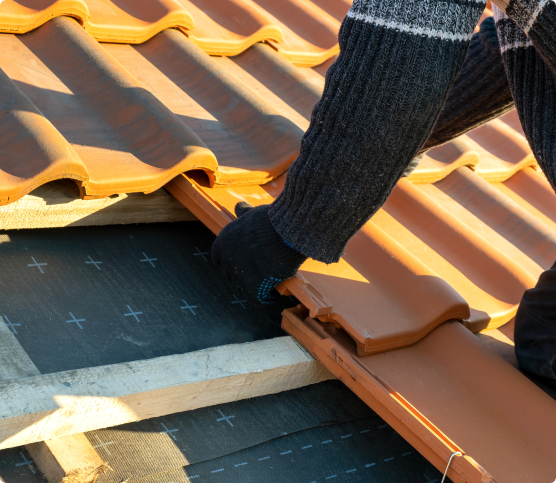Roof replacement is a significant investment that homeowners often face at some point in their lives. Whether it's due to age, damage, or simply the desire for an aesthetic upgrade, understanding the process and costs involved is crucial. In this ultimate guide, we will take you through the ins and outs of roof replacement, including the signs that indicate it's time for a new roof, the different roofing materials available, the factors impacting the cost, and the installation process. We will also explore the alternatives to replacement, such as roof repair, to help you make an informed decision about the best course of action for your home.

When it comes to the integrity of your home, the roof plays a crucial role in protecting you and your loved ones from the elements. However, over time, wear and tear can take its toll, and it's essential to recognize the signs that your roof may need replacement.
Before diving into the intricacies of roof replacement, it's important to be aware of the red flags that indicate your roof is showing signs of distress. These signs include:
Recognizing these signs promptly is crucial to prevent further damage to your home's interior and avoid costly repairs down the road.
Understanding the lifespan of different roofing materials can give you an idea of when to start considering replacement. Here's a general overview:
Keep in mind that these are rough estimates, and the lifespan of your roof can vary depending on factors such as climate, installation quality, and maintenance practices. Regular inspections by a professional roofing contractor can help you determine the condition of your roof and when replacement may be necessary.

The cost of roof replacement depends on several factors that contribute to the overall expense of the project. These factors include:
By considering these factors, you can get a better understanding of the estimated cost of your roof replacement project.
While it's difficult to provide an exact cost without assessing your specific requirements, it's useful to have a ballpark figure in mind to help with budgeting. On average, the national cost for a roof replacement falls between $5,000 and $10,000, with the final price depending on the aforementioned factors as well as your location. Keep in mind that this estimate may vary significantly based on the size, material choice, and complexity of your project.
It's essential to obtain quotes from reputable roofing contractors to get a more accurate estimate tailored to your unique situation. Remember to evaluate their credentials, experience, and customer reviews to ensure you choose a reliable and skilled professional for your roof replacement.
Roofing materials come in a variety of options, each with its own advantages and disadvantages. Here's a rundown of some commonly used materials:
Consider factors such as your budget, climate, and desired aesthetics when choosing the right roofing material for your home.
In recent years, environmental consciousness has led to a rise in sustainable roofing options. If you're concerned about minimizing your carbon footprint, you may want to consider eco-friendly alternatives. Some sustainable roofing materials include:
These options not only contribute to a greener planet but can also potentially lower your energy bills in the long run.
Prior to the installation, thorough preparation is necessary to ensure a smooth and successful project. Here are some key steps in the preparation process:
By taking these precautions, you can help ensure a safe and efficient installation process.
The installation process typically involves the following steps:
Having an experienced and skilled roofing contractor is essential for ensuring proper installation and a long-lasting roof.


While roof replacement is sometimes necessary, roof repair can be a viable solution for certain issues. Roof repairs are typically recommended for:
In these situations, repairing the damaged areas can be a cost-effective alternative to complete replacement. However, it's crucial to consult with a professional to assess the extent of the damage and determine the best course of action.


Roof replacement becomes necessary when extensive damage or age-related wear surpasses the ability to effectively repair the roof. Replacement is often recommended when:
Investing in a complete replacement ensures the long-term stability and protection of your home and provides an opportunity to upgrade to a more durable or visually appealing material.
Roof replacement is a significant undertaking, requiring careful consideration of various factors. Whether you choose to repair or replace your roof, understanding the signs of deterioration, the lifespan of different materials, and the cost implications will help you make an informed decision. Additionally, considering factors such as sustainability and the installation process can further enhance the outcome of your roofing project. By consulting with reputable professionals and weighing your options, you can ensure a well-protected and aesthetically pleasing roof that adds value to your home for years to come.
Table of Contents
Signs Your Roof Needs Replacement
Factors Influencing Roof Replacement Cost
Estimating the Cost of Roof Replacement
Choosing the Right Roofing Material
Pros and Cons of Common Roofing Materials
Sustainability and Roofing Materials
Preparing for Roof Installation
Step-by-Step Guide to Roof Installation
When Replacement is the Best Option
Conclusion
Join our mailing list for exclusive updates, expert tips, and special offers tailored to your needs. Be the first to know about the latest in home services.

Ask Ai

Renovize Home – Smarter, Stress-Free Home Projects.
Find licensed pros, compare estimates, and make confident decisions—all in one place. Renovize makes home improvements simple, fast, and tailored to you.
Home Services
Homeonwer Support
support@outrightllc.com
16192 Coastal Highway, Lewes, Delaware
© 2025 Outright. All rights reserved.